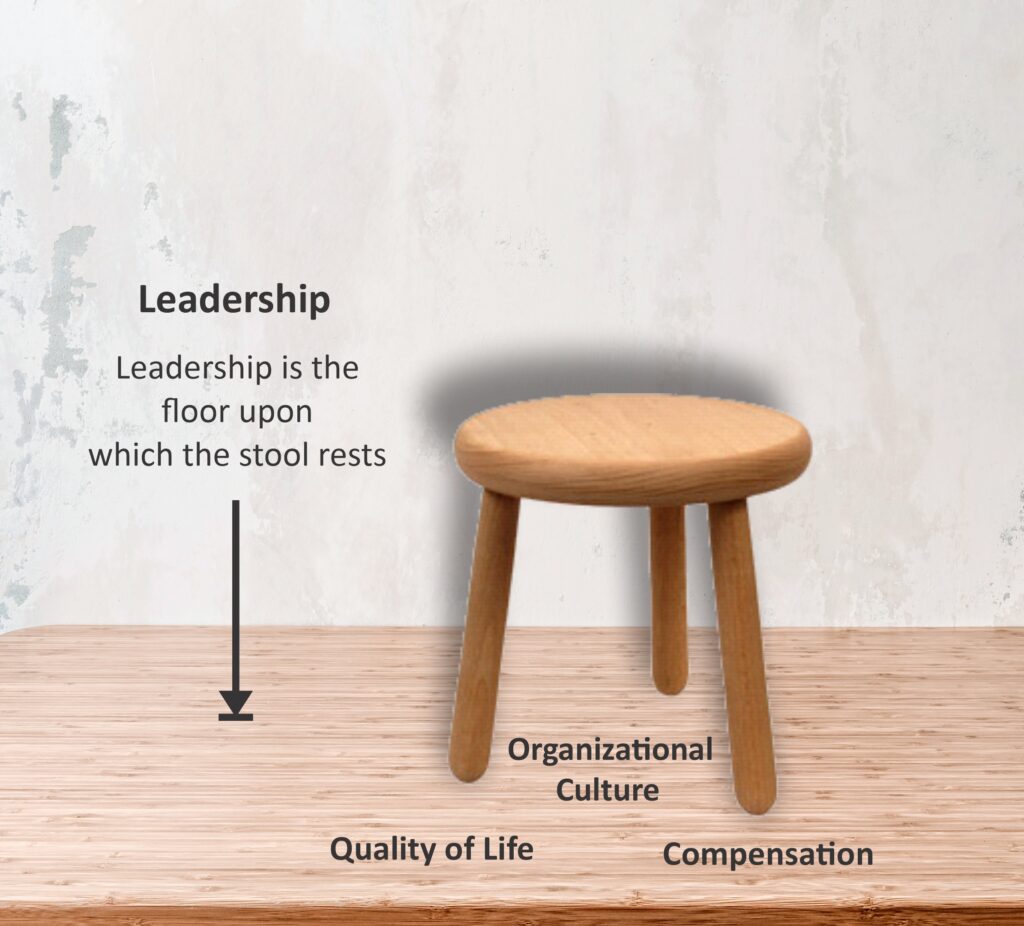
And correlating other parameters for compensation
At the end of last month’s article, I promised to discuss certain parameters that did and did not correlate with compensation levels – and we’ll get to those. But, as I was thinking about those parameters, a related topic occurred to me, a topic that is another important item in the retention equation.

In the figure above, we see a depiction of how the retention equation works. You have the three legs of the stool: compensation, organizational culture, and quality of life. If any one of the legs is neglected, the stool topples. All three legs require the support of leadership to stand. The legs are not independent stovepipes, however. If one of the legs doesn’t get the support it needs from leadership, other legs can and will be affected.
A quick case in point; I have a client who flies for a well-known business-aviation firm – one whose name you would recognize – and a brand I deeply respect. A few months ago, my client came to me for an analysis of his compensation level vs. the market. I ran the numbers and was shocked at how little he was paid. I provided him with the necessary documentation, and he used it to sit down with his superiors to have a conversation about compensation levels. His superiors weren’t interested. In fact, they became angry and shut the conversation down. Since the day that interaction occurred, there has been no subsequent discussion about compensation, and my client is now, of course, entertaining job offers from other potential employers. This is an example of how bad leadership can simultaneously infect both compensation and organizational culture, for by showing disdain for the compensation piece and reacting in an adversarial fashion in this case, the leadership of my client’s company revealed that the organization's culture is flawed.
Compensation Parameters – What Correlates and What Doesn’t
Very often, I have clients come to me for compensation analysis who are very eager to showcase how much they fly, how hard their personnel work, and how many nights they spend on the road. I enjoy hearing the stories because I love the people who work in our industry, and it’s wonderful hearing about the lengths they’ll go to in service to their principals. But when the conversation turns to the effect that workload has on compensation levels, I must put my statistician hat on and tactfully tell my clients that the answer is, sadly, there is none.
Here are the parameters that positively correlate with compensation levels:
- Position – generally, the higher up the “food chain” a position is, the higher the comp level.
- Jet Class – usually, the bigger the jet, the bigger the paycheck.
- Location – higher cost of labor in certain areas drives higher compensation. (Note that I didn’t say higher cost of living. Cost of labor and cost of living are different indices, although they do tend to correlate more often than not.)
- Part 91 vs Part 135 Operations – generally, pure Part 91 operations pay higher than pure Part 135 ones pay.
- Dual-Ratings – in most cases, a person who either flies or fixes both fixed-wing and rotary-wing aircraft makes more than one who flies or works on fixed-wing aircraft only.
- International Operations – those who operate internationally always make more than those who conduct domestic-only operations. This extends to flight attendants, flight technicians, and even schedulers.
Here are the parameters that do not correlate:
- Flight department size – you’d think the larger the flight department, the higher the compensation level. That is true for some positions but not for all of them, and even when there is a correlation, it is often not consistently positive.
- Years with a company/years in the industry – again, you’d think more experience would correlate with higher compensation, but it doesn’t – and the reason is understandable. Hiring managers pay what they need to pay to get the people they want, often with less tenure and even less experience.
- Hours flown/duty days/days on the road – absolutely no correlation at all. It does seem like there should be, but there isn’t.
The Commoditization of Quality of Life
The last bullet point above brings us to a topic that has increasingly been a focus for my clients. The question they ask goes something like this; “Do we really have to pay in the 75th percentile if we’re offering our personnel a great quality of life?” What they’re really asking about is whether they can commoditize the quality of life they offer in lieu of higher compensation.
Case in point. I had a client in the western U.S. who ran a flight department for a chain of casinos. He had a schedule where his pilots rotated on-call duty, but the schedule was published well in advance and it provided his personnel with ten hard days off per month, which is well above the four hard days off that is the average for multiple surveys. After some review and analysis, we agreed that he could target the 60thpercentile for compensation to show his personnel he was paying above market and make the case that their guaranteed time off was worth the dollar amount between the 60th and 75th percentiles. In short, he commoditized his personnel’s quality of life.
Let’s return to the retention stool above. In the retention research I did in 2017, the number-one reason pilots gave for leaving business aviation for the airlines was quality of life. They wanted to be able to plan their lives. The quality-of-life leg is just as important to the retention equation as the compensation one is, even in the current compensation environment. In fact, in more than one instance I’ve heard about, when pilots were given a choice between higher compensation and hiring another pilot, they chose the latter option in nearly every single case.
So, do compensation levels correlate to how hard people work or conversely to how little time they have off? No. But, assuming an organization can offer a predictable schedule, leadership probably doesn’t need to pay at the top of the scale to retain personnel. In the business aviation industry, a schedule that allows personnel to plan their lives is a rare commodity. Aviation managers should market it as such.




















































